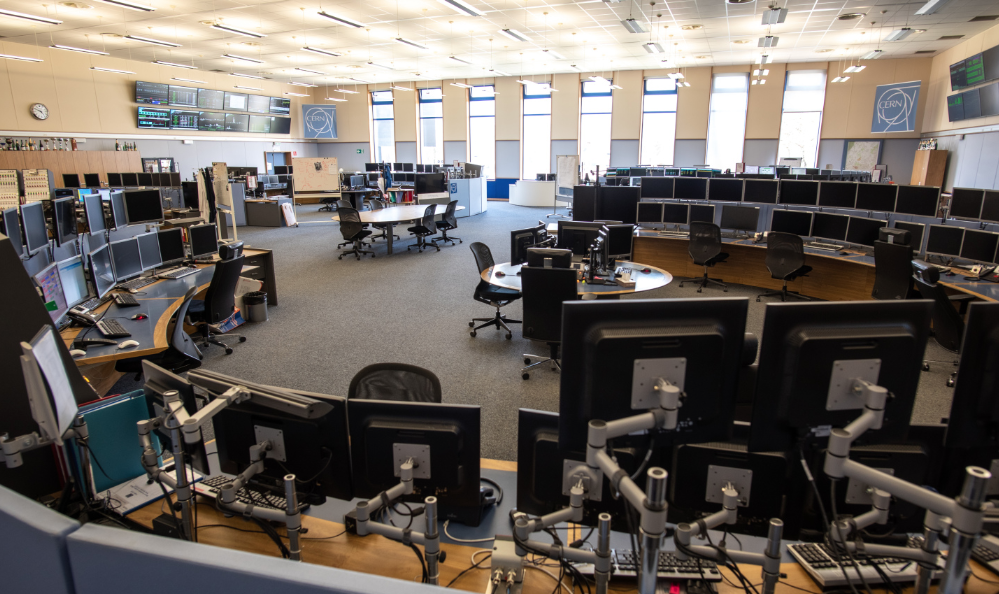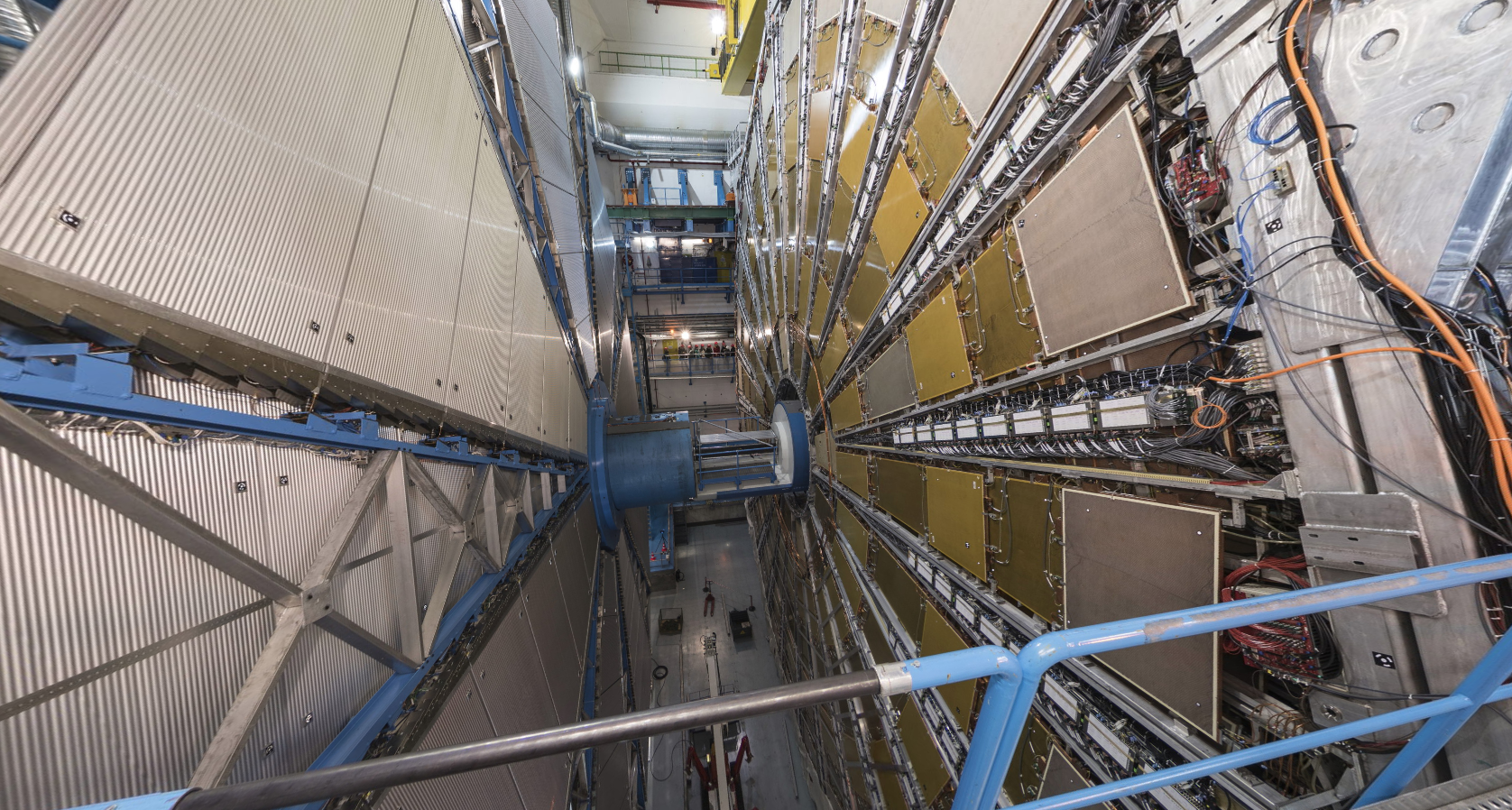Fabio Cerutti, a Berkeley Lab staff scientist and ATLAS group member, quickly transitioned to working from home after the COVID-19 pandemic led to a stoppage in most activities at the CERN site. Cerutti talks about his continuing work in this video. (Credit: Marilyn Sargent/Berkeley Lab)
Experiment: ATLAS, A Toiroidal LHC ApparatuS
About: The largest-volume detector ever built for a particle collider, ATLAS weighs about as much as the Eiffel Tower, and is about 82 feet in diameter and 150 feet long. It was integral in the discovery of the Higgs boson.
Location: CERN in Meyrin, Switzerland.
Role: Berkeley Lab scientists and engineers build hardware and software for the ATLAS experiment and also participate in theory work, data analysis, and ATLAS publications. The Lab’s Physics Division maintains an ATLAS Group.
Website: ATLAS
Note: This is part of a recurring series highlighting ongoing Berkeley Lab work in international physics collaborations during the COVID-19 pandemic.
Marjorie Shapiro, an experimental particle physicist and faculty senior scientist at the Department of Energy’s Lawrence Berkeley National Laboratory (Berkeley Lab), has been accustomed to working remotely and observing extreme social distancing from some colleagues for years, given that the scientific experiment she supports is 5,800 miles away.
A participant in the ATLAS collaboration – ATLAS (A Toroidal LHC ApparatuS) is a detector for the Large Hadron Collider, a particle collider at CERN in Switzerland – Shapiro said she has been fortunate in her ability to continue her work in the collaboration despite the global COVID-19 pandemic that has disrupted the lives and livelihoods of so many others.
Shapiro’s research is focused on software development and data analyses for ATLAS, including the development of more sophisticated computerized simulations to improve the quality and efficiency of the analyses. She is part of a dedicated ATLAS group at Berkeley Lab that participates in the international collaboration, which has about 3,000 members from over 180 institutions in 38 countries.
Some Lab Magnet Work Proceeds on Particle Accelerator Upgrade
While COVID-19 risks had led to a temporary halt in fabrication work on high-power superconducting magnets built by a collaboration of three U.S. Department of Energy national labs for an upgrade of the world’s largest particle collider at CERN in Europe, researchers at Berkeley Lab are still carrying out some project tasks.
While most on-site operations were suspended at Berkeley Lab and CERN in mid-March, supercomputers at Berkeley Lab’s National Energy Research Scientific Computing Center (NERSC) have remained up and running, allowing Shapiro to continue her analyses work.
“NERSC is the primary place where we’re doing our analyses,” Shapiro noted. “The staff have been doing a great job. We’ve had no problems in terms of access. When we have questions, they are answering them. On the software and computational front, they get really high marks for being able to continue to function.”
One of Shapiro’s priority tasks is in improving the ATLAS data analyses to account for new theoretical models. She also is involved in a redesign of the ATLAS software to accommodate a much higher volume of data from a planned upgrade known as the High-Luminosity LHC (HL-LHC) project that will generate a higher rate of particle collisions at the LHC.
She noted that the next planned run for the LHC, dubbed Run 3, “will be kind of a prototype for what we need to do for HL-LHC. We hope to verify that the software works in Run 3” in properly characterizing the data, she said.
Researchers who had been working on ATLAS hardware development on-site at CERN for the HL-LHC ATLAS detector upgrade have had to pause on some of those efforts, but they are supporting the collaboration in other ways. And some members of Berkeley Lab’s ATLAS team who were accustomed to short visits or prolonged stints working at the CERN site have been unable to travel to the site.
Fabio Cerutti, a senior member of Berkeley Lab’s ATLAS Group who had been working on-site at CERN, said it was an easy transition for him to work from his home in Switzerland, though he misses the in-person discussions with colleagues.
Cerutti has been involved since the early years of ATLAS with physics analyses related to the Higgs boson, and recently was elected as a deputy chairperson for a committee that oversees ATLAS scientific publications.
“My time is spent very similarly to what it was at CERN,” he said. “The change has not been so dramatic. My day was full of in-person meetings, now they are remote meetings.”
Shapiro said that her visits to CERN had already been limited by her duties as a physics professor at UC Berkeley. So she is used to participating in regularly scheduled early-morning calls with local members of the ATLAS collaboration and others working overseas.
“Our collaboration has always been virtual because we’re worldwide,” she said, “so our collaboration will probably be in better shape than most.”
She added, “The thing that’s difficult is the meetings where we are making decisions – and especially decisions where there are differences of opinion.” There are nuances in online video-based interactions that might be easier to pick up on in person, she noted.
Cancellations, or virtual substitutions of large, in-person scientific workshops and conferences are now the norm, and Shapiro said she had been looking forward to attending an LHC physics conference in Paris that had been scheduled later this month. Now she will participate in a virtual form of the meeting.
“Getting up in the middle of the night to give a talk online doesn’t sound nearly as exciting as going to Paris and talking to people,” she said. The in-person conferences had also traditionally served as a gentle nudge for physicists to prepare and share their latest research, she said.
Members of Berkeley Lab’s ATLAS group have worked to establish some more social interactions online during this time, such as the use of the Slack online sharing platform and the start of a virtual coffee hour for members to gather online.
“This isn’t just to make sure you’re working,” she said, “It’s to make sure you’re OK. I think it makes a difference. And I’m still trying to get together with student researchers one-on-one at least once or twice a week.”

The CERN Control Center is nearly empty due to a temporary shutdown in most on-site operations in response to the COVID-19 pandemic. (Credit: Michael Struik/CERN)
Shapiro said that in her professorial work on campus, she has noticed some drop-off in the level of student engagement in classes conducted online versus in-person, and some students aren’t able to participate in her live online class due to time differences.
There are also challenges in hiring during this time of shelter-in-place. In the latest batch of interviews of Divisional Fellow candidates for Berkeley Lab’s Theory Group, some of the interviews had been conducted in-person before the Lab’s partial shutdown of operations while others had to be conducted virtually after the partial shutdown.
Shapiro is working with one student researcher who is just finishing up her Ph.D. thesis. “Typically, we would sit in a room together. Now, I’m putting the comments in a PDF file,” she said.
Even so, work has been surprisingly accessible, she said. “For anything that doesn’t require a physical presence at the Lab, we’re finding ways to get around.”
NERSC is a DOE Office of Science user facility.
See other articles in this series:
• Some Lab Magnet Work Proceeds on Particle Accelerator Upgrade
• Daya Bay Reactor Experiment Continues to Generate Data
• Site of LUX-ZEPLIN Dark Matter Search Project Carefully Ramps Up Science Work
• CUORE Underground Experiment in Italy Carries on Despite Pandemic
• DESI Team Prepares for Telescope Instrument’s Restart after Unexpected Shutdown
More:
A Gradual Restart Plan for CERN’s On-Site Activities
# # #
Founded in 1931 on the belief that the biggest scientific challenges are best addressed by teams, Lawrence Berkeley National Laboratory and its scientists have been recognized with 13 Nobel Prizes. Today, Berkeley Lab researchers develop sustainable energy and environmental solutions, create useful new materials, advance the frontiers of computing, and probe the mysteries of life, matter, and the universe. Scientists from around the world rely on the Lab’s facilities for their own discovery science. Berkeley Lab is a multiprogram national laboratory, managed by the University of California for the U.S. Department of Energy’s Office of Science.
DOE’s Office of Science is the single largest supporter of basic research in the physical sciences in the United States, and is working to address some of the most pressing challenges of our time. For more information, please visit energy.gov/science.
